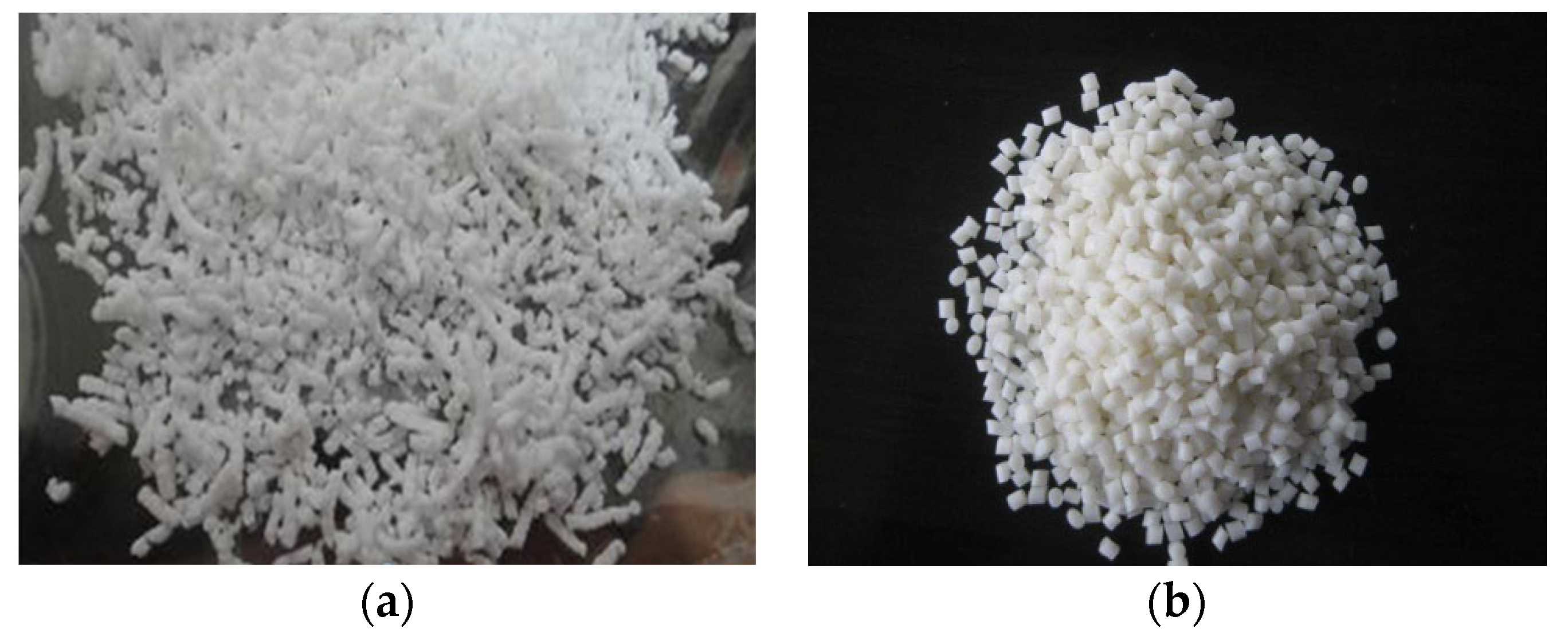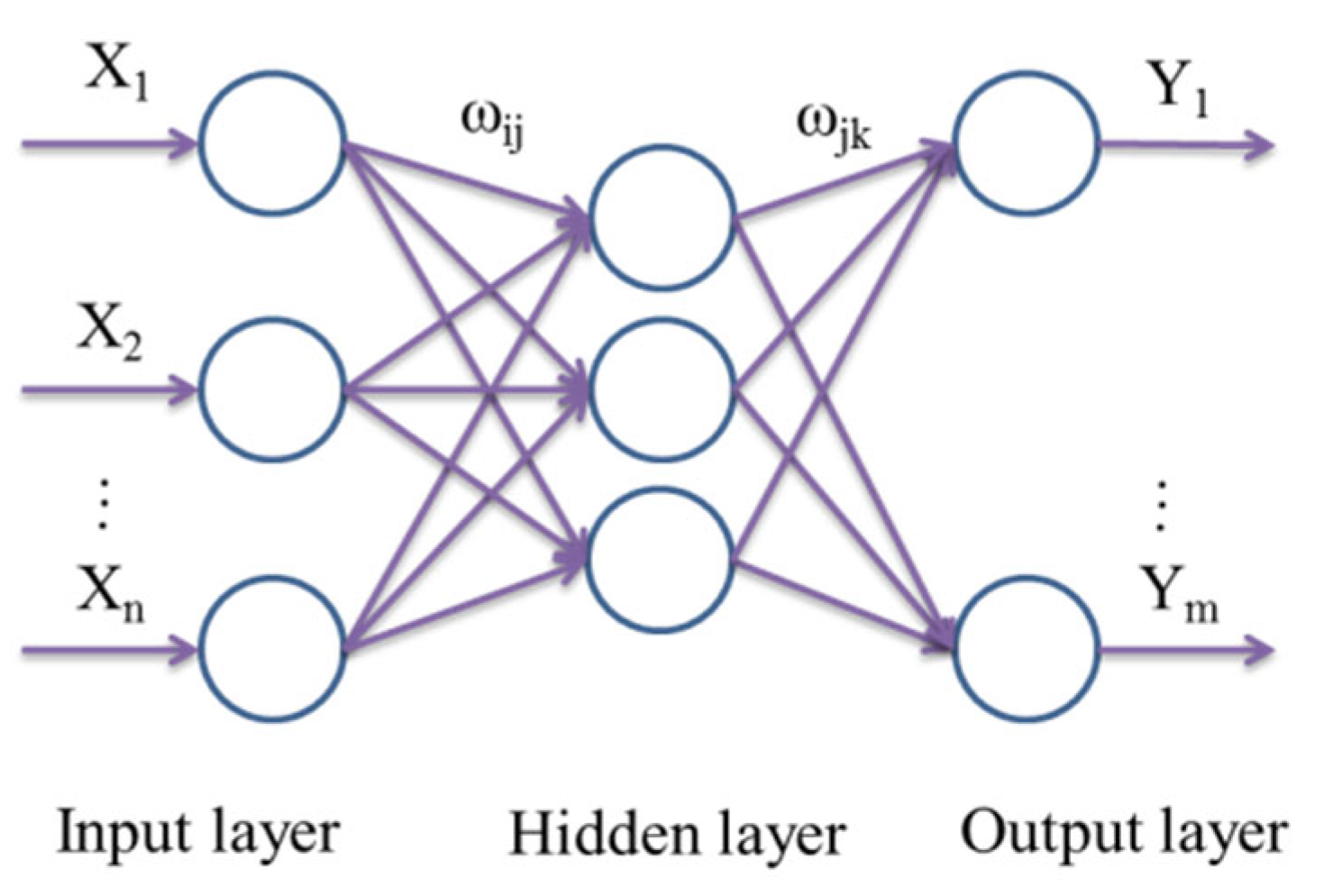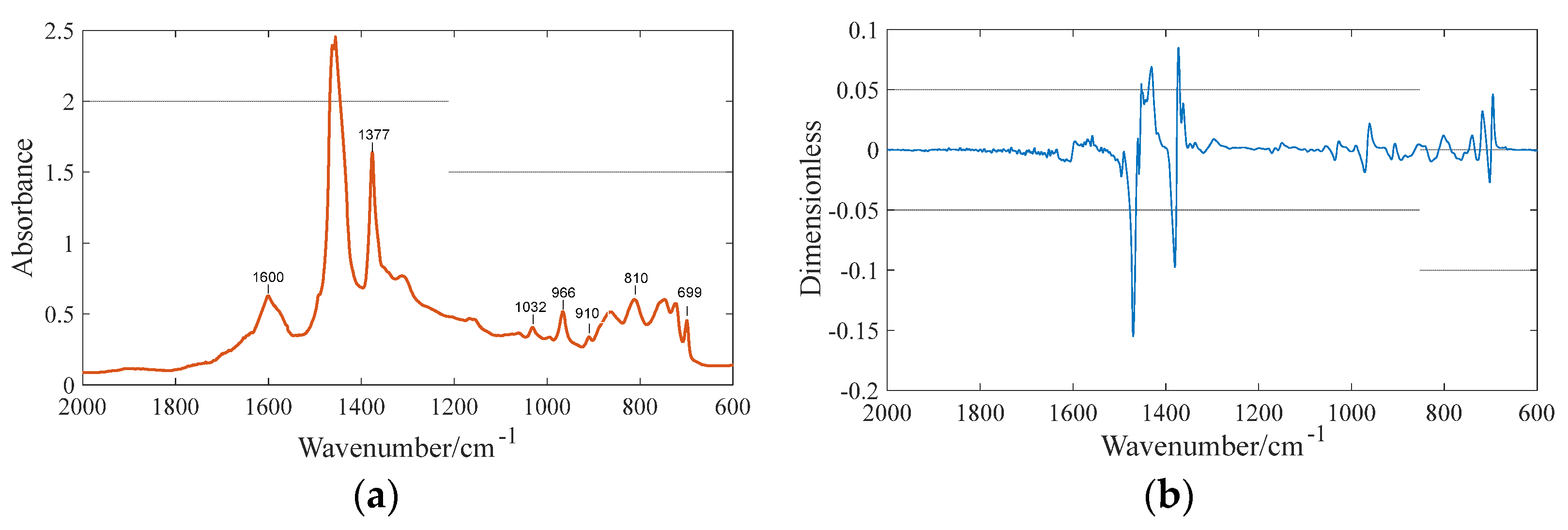Artificial Neural Network (ANN) Modeling for Predicting Performance of SBS Modified Asphalt
Abstract
1. Introduction
2. Experimental Procedures
2.1. Materials
2.2. Sample Preparation and Test Method
3. Artificial Neural Networks (ANNs)
3.1. Background
3.2. Model Construction
3.3. Data Preprocessing
3.4. Model Optimization
4. Results and Discussion
4.1. SBS Content Prediction Model
4.2. The Softening Point and Penetration Prediction Model
5. Conclusions
Author Contributions
Funding
Informed Consent Statement
Data Availability Statement
Conflicts of Interest
References
- Kök, B.V.; Yilmaz, M.; Çakiroğlu, M. Neural network modeling of SBS modified bitumen produced with different methods. Fuel 2013, 106, 265–270. [Google Scholar] [CrossRef]
- Valtorta, D.; Poulikakos, L.D.; Partl, M.N. Rheological properties of polymer modified bitumen from long-term field tests. Fuel 2007, 86, 938–948. [Google Scholar] [CrossRef]
- Zhao, X.; Wang, S.; Wang, Q. Rheological and structural evolution of SBS modified asphalts under natural weathering. Fuel 2016, 184, 242–247. [Google Scholar] [CrossRef]
- Kök, B.V.; Yilmaz, M.; Guler, M. Evaluation of high temperature performance of SBS + Gilsonite modified binder. Fuel 2011, 90, 3093–3099. [Google Scholar] [CrossRef]
- Airey, G.D. Styrene butadiene styrene polymer modification of road bitumens. J. Mater. Sci. 2004, 99, 951–999. [Google Scholar] [CrossRef]
- Singh, M.; Kumar, P. Determination of Mixing and Compacting Temperatures for Neat and Modified Bitumen. J. Pharm. Biomed. Anal. 2015, 51, 617–625. [Google Scholar]
- Zhang, F.; Yu, J. The research for high-performance SBR compound modified asphalt. Constr. Build. Mater. 2010, 24, 410–418. [Google Scholar] [CrossRef]
- Burns, D.A.; Ciurczak, E.W. (Eds.) Handbook of Near-Infrared Analysis, 3rd ed; CRC: New York, NY, USA, 2007. [Google Scholar]
- Lin, C.; Chen, X.; Jian, L. Determination of grain protein content by near-infrared spectrometry and multivariate calibration in barley. Food Chem. 2014, 162, 10–15. [Google Scholar] [CrossRef]
- Prevolnik, M.; Škrlep, M.; Janeš, L. Accuracy of near infrared spectroscopy for prediction of chemical composition, salt content and free amino acids in dry-cured ham. Meat Sci. 2011, 88, 299–304. [Google Scholar] [CrossRef]
- Paz, J.M.; Visconti, F.; Chiaravalle, M. Determination of persimmon leaf chloride contents using near-infrared spectroscopy (NIRS). Anal. Bioanal. Chem. 2016, 408, 3537. [Google Scholar] [CrossRef]
- Li, J.; Chu, X.; Tian, S. Research on Determination of Total Acid Number of Petroleum Using Mid-infrared Attenuated Total Reflection Spectroscopy. Energy Fuels 2012, 26, 5633–5637. [Google Scholar]
- Yuan, H.; Chu, X.; Li, H. Determination of multi-properties of residual oils using mid-infrared attenuated total reflection spectroscopy. Fuel 2006, 85, 1720–1728. [Google Scholar]
- Kovalenko, I.V.; Rippke, G.R.; Hurburgh, C.R. Determination of amino acid composition of soybeans (Glycine max) by near-infrared spectroscopy. J. Agric. Food Chem. 2006, 54, 3485–3491. [Google Scholar] [CrossRef] [PubMed]
- Jin, X.; Shi, C.; Yu, C.Y. Determination of Leaf Water Content by Visible and Near-Infrared Spectrometry and Multivariate Calibration in Miscanthus. Front. Plant Sci. 2017, 8, 721. [Google Scholar] [CrossRef] [PubMed]
- Wang, H.; Deng, W.G.; Li, C.B.; Zhang, B.; Yin, C.Z. Study on the Prediction Model of Key Indicators for SBS Modified Asphalt. Petroleum 2017, 31, 22–26. [Google Scholar]
- Zhong, K.; Cao, D.W.; Luo, S. Determination the Modifier Content in SBS Modified Asphalt Based on Infrared Spectroscopy Technique. Appl. Mech. Mater. 2010, 34, 1129–1134. [Google Scholar] [CrossRef]
- Hasan, M.A.; Mannan, U.A.; Tarefder, R.A. Determination of Polymer Content in SBS Modified Asphalt Binder Using FTIR Analysis. In Proceedings of the International Conference on Construction in the Century, Dubai, United Arab Emirates, 5–7 March 2017. [Google Scholar]
- Sun, D.Q.; Zhang, L.W. Quantitative Determination of SBS Content in SBS Modified Asphalt. J. Build. Mater. 2013, 16, 180–184. [Google Scholar]
- Civera, M.; Fragonara, L.Z.; Surace, C. A novel approach to damage localisation based on bispectral analysis and neural network. Smart Struct. Syst. 2017, 20, 669–682. [Google Scholar]
- Araba, A.M.; Memon, Z.A.; Alhawat, M.; Ali, M.; Milad, A. Estimation at Completion in Civil Engineering Projects: Review of Regression and Soft Computing Models. Knowl. Based Eng. Sci. 2021, 2, 1–12. [Google Scholar] [CrossRef]
- Tang, J.Q.; Ma, Q.F.; Shi, J.T. Rapid FTIR-ATR Method for the Quantification of Bitumen Property. Spectrosc. Spectr. Anal. 2016, 36, 672–675. [Google Scholar]
- JTG E20–2011; Standard Test Methods of Bitumen and Bituminous Mixtures for Highway Engineering. Ministry of Transport of the People’s Republic of China: Beijing, China, 2011.
- Esen, H.; Inalli, M.; Sengur, A. Performance prediction of a ground-coupled heat pump system using artificial neural networks. Expert Syst. Appl. 2008, 35, 1940–1948. [Google Scholar] [CrossRef]
- Zhang, H.B.; Wang, F.Q. Study on the Method of Rapid Detection of SBS Content in Modified Asphalt Based on ANN Prediction Model. West. Transp. Sci. Technol. 2020, 2020, 2513147. [Google Scholar]
- Dou, Y.Y.; Xu, X.Q. Rapid Detection Method of SBS Content in Modified Asphalt Based on ATR-FTIR. China Build. Mater. Sci. Technol. 2021, 30, 12–15. [Google Scholar]







| Category | Penetration (25 °C, 0.1 mm) | Ductility (15 °C)/cm | Softening Poi1nt/°C | Viscosity (135 °C)/mPa s | Viscosity (175 °C)/mPa·s |
|---|---|---|---|---|---|
| Sinopec | 56.0 | >150 | 50.5 | 473.4 | 90.2 |
| Cnooc | 67.0 | >150 | 49.3 | 435.1 | 84.7 |
| Shell | 75.3 | >100 | 49.9 | 422.1 | 83.0 |
| Performance Indicators | Unit | Test Results |
|---|---|---|
| Ash | % | 0.16 |
| 300% tensile stress | MPa | 2.4 |
| Volatile fraction | % | 0.88 |
| Melt flow rate | g/(10 min) | 0.03 |
| Tear elongation | % | 720 |
| Methods | RMSE | R2 | COV |
|---|---|---|---|
| 1st derivative | 0.031 | 0.921 | 0.80 |
| 2nd derivative | 0.040 | 0.862 | 1.02 |
| Smoothing | 0.026 | 0.944 | 0.67 |
| 1st derivative + Smoothing | 0.010 | 0.993 | 0.29 |
| Modeling Interval | RMSE | R2 | COV |
|---|---|---|---|
| 400~4000 cm−1 | 0.15 | 0.73 | 3.8 |
| 650~1300 cm−1 | 0.02 | 0.97 | 0.5 |
| 680~720 cm−1 and 880~1050 cm−1 | 0.01 | 0.99 | 0.25 |
| Training Algorithm | Number of Hidden Neurons | R2 | RMSE |
|---|---|---|---|
| L-M | 7 | 0.9987 | 0.0025 |
| L-M | 5 | 0.9986 | 0.0027 |
| L-M | 3 | 0.9982 | 0.0035 |
| B-R | 7 | 0.9982 | 0.0035 |
| B-R | 5 | 0.9982 | 0.003 |
| B-R | 3 | 0.9982 | 0.0036 |
| SCG | 7 | 0.9946 | 0.0106 |
| SCG | 5 | 0.9976 | 0.0048 |
| SCG | 3 | 0.9958 | 0.0086 |
| Model Type | Modeling Interval (cm−1) | Number of Asphalt Type | Sample Size | R2 | RMSE |
|---|---|---|---|---|---|
| penetration prediction model | 3100~2800, 1650~1300, 1050~680 | 1 | 50 | 0.982 | 1.56 |
| 2 | 100 | 0.977 | 2.45 | ||
| 3 | 150 | 0.922 | 6.63 | ||
| Softening point prediction model | 1700~1300, 1050~680 | 1 | 50 | 0.964 | 3.36 |
| 2 | 100 | 0.96 | 3.07 | ||
| 3 | 150 | 0.945 | 4.35 |
Publisher’s Note: MDPI stays neutral with regard to jurisdictional claims in published maps and institutional affiliations. |
© 2022 by the authors. Licensee MDPI, Basel, Switzerland. This article is an open access article distributed under the terms and conditions of the Creative Commons Attribution (CC BY) license (https://creativecommons.org/licenses/by/4.0/).
Share and Cite
Zhong, K.; Meng, Q.; Sun, M.; Luo, G. Artificial Neural Network (ANN) Modeling for Predicting Performance of SBS Modified Asphalt. Materials 2022, 15, 8695. https://doi.org/10.3390/ma15238695
Zhong K, Meng Q, Sun M, Luo G. Artificial Neural Network (ANN) Modeling for Predicting Performance of SBS Modified Asphalt. Materials. 2022; 15(23):8695. https://doi.org/10.3390/ma15238695
Chicago/Turabian StyleZhong, Ke, Qiao Meng, Mingzhi Sun, and Guobao Luo. 2022. "Artificial Neural Network (ANN) Modeling for Predicting Performance of SBS Modified Asphalt" Materials 15, no. 23: 8695. https://doi.org/10.3390/ma15238695
APA StyleZhong, K., Meng, Q., Sun, M., & Luo, G. (2022). Artificial Neural Network (ANN) Modeling for Predicting Performance of SBS Modified Asphalt. Materials, 15(23), 8695. https://doi.org/10.3390/ma15238695






